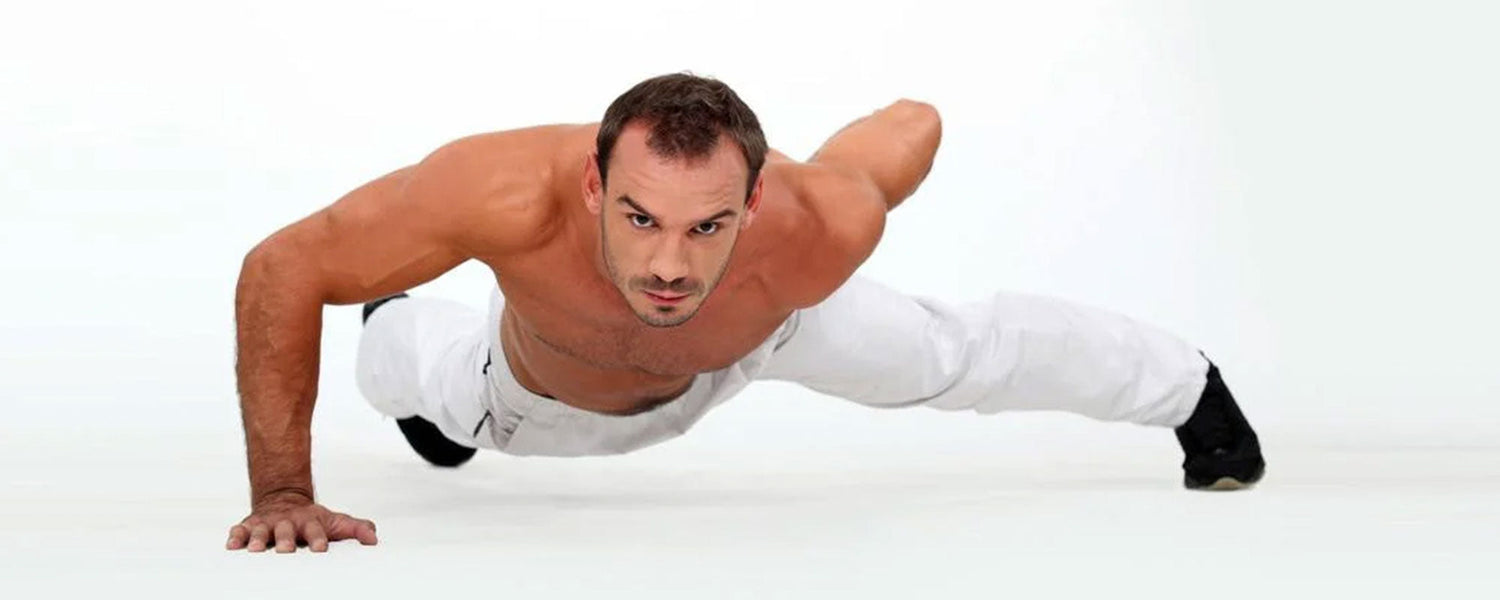Table of content
1. Introduction
The biceps, also known as the “glamour muscles,” is a rewarding muscle group to focus on since they show significant improvements rapidly. However, you don't need to spend a lot of money to impress.
Here are some of the best at-home no-equipment bicep workouts to help you get started.
2. Biceps Anatomy

- Biceps are located on the front of the upper arm and they are antagonist (work opposite) to the triceps muscles, a muscle that runs along the back of your upper arm.
- The biceps consists of three parts: biceps brachii short head, biceps brachii long head, and brachialis. Building proper biceps requires focusing on each of these parts equally.
3. How to get Bigger Biceps Without Equipment?
3.1. Use Your Body Weight
The best way to work your biceps without any equipment is to use your body’s weight as resistance.
Body weight is an effective tool that not only focuses on the biceps but also targets other muscle groups. You don’t need any specific equipment for such training, yet it can help you get stronger and bigger biceps at home.
How does it work?
Exercises involving body weight are great at stimulating muscle growth if your muscles are under pressure for a certain amount of time. Daily workouts can strengthen your biceps and help you build muscle if you follow these basic principles:
- Perform compound workouts with variations
- Increase the number of repetitions over time
- Reduce resting interval in between the exercises
- Use mechanical drop sets when doing bodyweight exercises to grow muscle
Also read: What is the Correct Way to Do Calf Raises?
4. Things to Consider Beforehand
Firstly , you need to figure out your workout routine, starting with determining the number of reps and frequency of your exercises.
4.1. Frequency of Workout
There is no one-size-fits-all solution when it comes to determining the number of times you should do a bicep workout.
The number of your biceps days of training is determined by the following factors:
- Your diet and intake
- Your workout schedule
- The intensity of your activities
- How quickly you want to get results
As a general rule of thumb, working your biceps two to three times a week is sufficient to promote muscle growth.
However, always remember that if you train too hard without any rest, your biceps will not grow if you suffer an injury.
If you're experiencing DOMS (delayed onset muscle soreness), take a break or go easier on your biceps exercises.
4.2. Number of Reps
Consider the goal of your biceps workout when determining how many repetitions you'll do for each exercise in your program.
- If your primary goal is to improve muscle strength and mass, do 4 to 6 repetitions.
- If your focus is on bulking and adding as much mass as possible, do 8 to 12 repetitions.
- If you want to improve your muscle endurance, do 16 to 20 repetitions.
- In the beginning, try doing three sets of each exercise.
5. Best No-Equipment Workouts for Bigger Biceps at Home
Body weight exercises are great at building biceps if you don’t want to lift any sort of weights or use equipment. Such exercises are convenient to perform and can help you effectively work your biceps at home. These include:
5.1. Push-ups
Push-ups are great for building core strength and upper body muscles. A standard push-up targets your core, chest, deltoid, arms, and shoulders.
A standard push-up may not be as effective in building biceps as it targets multiple muscle groups. But adding slight variations in the technique can help mainly target your biceps.
Following are a few push-up workouts that you can use to build your biceps at home.
One Arm Push-up
The one arm or single-arm push-up focuses on your biceps and triceps, also targeting your chest and shoulders. It’s a great way to build your biceps without any equipment at home.
How to Perform?
- Begin with a regular push-up.
- Place one arm behind your back and the other in front of you.
- Activate your core.
- Lower yourself gradually until your chest is practically touching the ground. Maintain a straight back and a body that is parallel to the floor.
- Push yourself up after holding the position for two seconds.
- When you completed one set of this workout for one arm, switch arms.
Workout Plan:
- Complete three to four sets of 10-15 reps.
Diamond Push-up
Diamond push-ups are effective workouts for both triceps and biceps. They help to build your upper arm muscles and engage multiple muscle groups in your body.
Diamond push-ups receive their name from the shape your hands form, which helps you train your biceps by bringing your arms closer together.
How to Perform?
- Begin in a standard push-up position with your back flat and parallel to the ground.
- Keep your arms straight by placing your hands together on the floor.
- Then rotate your hands almost 45 degrees inwards. Extend your thumbs so that the open space between your fingers and thumbs looks like a diamond.
- Gradually lower your body until your chest is almost touching the ground. Make sure to engage your core.
- Hold for two seconds and then push yourself up.
- Repeat.
Workout Plan:
- Perform at least three sets with 15-20 repetitions.
Inside Reverse Hand Push-up
The key to target biceps is to produce more arm-curling motion. The inside reverse hand push-ups help achieve this movement by changing the alignment and position of both your hands and torso.
How to Perform?
- Begin with a standard push-up position with your arms extended and your hands placed on the floor wider than shoulder-width.
- Now rotate your hands such that your fingers are facing the wall behind you.
- Place your hands in alignment with your mid-back.
- Then lower your body down by tucking your elbows in towards your body until your chest touches the ground.
- Then push your body back up and repeat.
Workout Plan:
- Complete three to four sets with 10-15 reps.
5.2. Chin-Up
Chin-up is another body weight exercise that builds up your biceps and strengthens your back.
To target your biceps with chin-ups, make sure to follow the supinated or under grip (palms facing towards you).
If you follow the pronated grip (palms facing away from you), chin-ups will work your back muscles more than your biceps.
How to Perform?
You don’t need to have access to a fitness bar at the gym to perform this exercise. You can use an alternative at home such as a simple steel bar installed in your doorway or your child’s swing.
- Grab the bar by placing your hands closer than shoulder-width. Keep your palms facing backward.
- Hang onto the bar by engaging your core.
- Slowly pull yourself up by tightening your biceps and pulling your elbows down.
- Keep pulling yourself up until your chin reaches above the bar. Hold for about two seconds.
- Then slowly lower yourself until your arms are extended straight and repeat.
Workout Plan:
- Complete at least three sets of 10-15 reps.
5.3. Inverted Row
Inverted row is a compound exercise that engages multiple muscle groups including biceps, triceps, back, and forearms.
It can be of great help in building biceps as the muscles in the biceps and core play a crucial role in moving the body towards the bar.
You can perform this exercise at home without any gym equipment by using bedsheets, hockey sticks, or installing a low bar.
How to Perform?
- Stand with your body straight and grab whatever object is available e.g. table, bedsheet, bar, etc.
- Keep your thighs contracted and your core engaged.
- Pull your body up while tucking in your elbows.
- Slowly lower yourself from the top position until you get back to the starting pause.
- Make sure to exhale as you move up and inhale as you move down.
Workout Plan:
- Complete at three to four sets of 8-10 reps.
5.4. Pull-up
Pull-ups are an excellent way to build stronger biceps and forearms. You can perform this workout at home with a simple steel bar hanging around a door.
How to Perform?
- Hold the pull-up bar with your palms facing forwards and your hands apart at shoulder width.
- Hang onto the bar by engaging your core.
- Then pull yourself up by moving your elbows down and bringing your upper back muscles closer together.
- Pull until your chin reaches the bar and hold for two seconds.
- Then slowly lower yourself by straightening your arms and then repeat.
Workout Plan:
- Perform three to four sets with 10-15 reps.
5.5. Planks
A plank is a compound exercise that engages multiple muscle groups at a time: the core, upper body, and lower body.
But adding slight variations to the standard plank can help you target your biceps effectively. Such plank variations involve slight changes in body positions and movements which help to work your shoulders, biceps, and triceps while tightening your core and back simultaneously.
Planks that are specifically designed to exert biceps include:
Side Plank
Side plank targets muscles in the biceps, triceps, shoulders, and oblique muscles (muscles that run along the side of your core).
How to Perform?
- Begin with a standard plank or push-up position.
- Gradually turn your body to one side, making sure that your head and toe are aligned.
- Lift your one arm so that it points straight towards the sky or rest it on your pectoral region.
- Stay in that position for about 30 seconds while keeping both arms perpendicular to the floor.
- Then lower your body to the standard plank position.
- Repeat on the other side.
Workout Plan:
- Perform at least three sets with 10-12 reps on each side.
Plank Shoulder Tap
Planks with shoulder tap work your shoulders, biceps, core, hamstrings, and deltoid.
How to Perform?
- Begin in a standard plank position with straight arms.
- Keep your shoulders and hands aligned, your legs straight, and your feet apart at hip-
- Lift your right hand from the ground and touch your left shoulder. Lower your hand down to the floor.
- Do the same movement with the other side and repeat.
Workout Plan:
- Perform at least three sets with 10-15 reps on each side.
- Try to continue the movement for 50 to 60 seconds in each set.
Up-Down Plank
Up-down plank is another excellent workout that targets your biceps and shoulders.
How to Perform?
- Start with a lower plank position with weight placed on your forearms.
- Extend one arm straight by placing your palm flat on the ground.
- Then straighten your other arm so that both of your palms are flat on the floor.
- Then lower both of your arms one by one, placing both your forearms on the floor as you return to the original lower plank position.
- Repeat.
Workout Plan:
- Complete three to four sets with 8-12 reps.
6. Biceps Workouts with Resistance Band
Resistance bands are more effective than weight training when building biceps due to their variable tension. As you squeeze your biceps with a resistance band, the exercise gets harder and it works your bicep harder than weight training.
6.1. Standing Biceps Curl
How to Perform?
- Stand straight and place a resistance band beneath your feet.
- Hold the resistance band in your hands and start pulling it upwards while keeping your back straight and chest up.
- Lift the handles until your hand reaches your
- Then lower your hands again and repeat.
Workout Plan:
- Complete three sets with 10-12 reps.
- Take rest for 45 seconds in between.
6.2. Seated Biceps Curl
How to Perform?
- Sit on a chair and place a resistance band underneath your hips.
- Hold the resistance band in your hands and start pulling it upwards while keeping your back straight and chest up.
- Lift the handles until your hand reaches your
- Then lower your hands again and repeat.
Workout Plan:
- Complete three to four sets with 10-12 reps.
- Take rest for 45 seconds in between.
7. Beginner Bicep Workout at Home
| Set 1 | |||
|---|---|---|---|
| Workout | Reps | Sets | Rest |
| One arms Push up | 10 | 3 | 30 seconds |
| Side Plank | 10 | 3 | 30 seconds |
| Diamond Push up | 10 | 3 | 30 seconds |
| Set 2 | |||
|---|---|---|---|
| Workout | Reps | Sets | Rest |
| Plank shoulder tap | 12 | 3 | 40 seconds |
| Inside Reverse Hand Push up | 12 | 3 | 40 seconds |
| Diamond Push up | 12 | 3 | 30 seconds |
| Set 3 | |||
|---|---|---|---|
| Workout | Reps | Sets | Rest |
| Standing Biceps Curl | 10 | 3 | 30 seconds |
| Inverted Rows | 10 | 3 | 30 seconds |
| Seated Biceps Curl | 10 | 3 | 30 seconds |
8. Takeaways
You don’t need to perform all of the above exercises at once. Choose four to five exercises that you can easily perform and incorporate them into your weekly workout routines.
Moreover, make sure to feed your working muscles with sufficient amounts of proteins through a healthy diet. It is important because working out can create small tears in your muscles which require a specific amount of amino acids to repair and grow.













Leave a comment
This site is protected by hCaptcha and the hCaptcha Privacy Policy and Terms of Service apply.